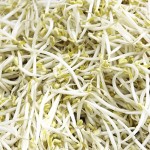 Sprouts are a tasty and nutritious addition to any meal (or snack), anytime of the day. I love, and so does the rest of the family, tiny little radish sprouts served over cottage cheese….Mmmm! they’re so good.
Sprouts are a tasty and nutritious addition to any meal (or snack), anytime of the day. I love, and so does the rest of the family, tiny little radish sprouts served over cottage cheese….Mmmm! they’re so good.
I know what your thinking though….. Sprouting, that’s just too difficult and time consuming for me…I don’t think I can do it.
Well I am here to tell you, YES you can!
I was once where you are…thinking it was just too difficult. But, I stepped out and gave it a go. And it really wasn’t hard at all, you will see this for yourself once you give it a try,
But before we get into the “how to” of sprouting, first let’s look at what a sprout is and why we should consider sprouting.
What is a Sprout?
A sprout is a seed/grain/legume that has begun the germinating process (when a seed grows and becomes a tiny “living” plant).
Why Sprout?
All seeds, grains, nuts, and legumes contain Phytic Acid & Enzyme Inhibitors. These anti-nutrients basically act like the body guard/protector of the seed, to keep it from sprouting or “growing” prematurely. In turn these anti-nutrients keep the vitamins and minerals within the seed locked up and not readily available to you; and because of this the seed is also harder to digest. Sprouting will release/neutralize these anti-nutrients, which unlocks the nutrients within the seed and makes is much easier to digest. (Soaking is another method that is sometimes useful as well to unlock these nutrients, such as in the case with Raw Nuts…see How to Soak Raw Nuts.)
More on Phytic Acid & Enzyme Inhibitors
Phytic Acid binds with minerals (calcium, magnesium, iron, copper, and zinc), which makes it quite difficult or just about impossible for them to be absorbed. Phytic Acid has also been known to irritate the digestive system.
Enzyme Inhibitors do just as their name says….they inhibit enzymes important for proper digestion of the seed, therefore making the seed hard to digest.
In her book Nourishing Traditions, Sally Fallon lists more reasons that we should sprout.
“Sprouting inactivates aflotoxins, potent carcinogens found in grains.”
“The process of germination not only produces vitamin C, but also changes the composition of grains and seeds in numerous beneficial ways. Sprouting increases vitamin B content, especially B2, B5, and B6. Carotene increases dramatically-sometimes even eightfold.”
The above quotes are found on Pg. 112 of Nourishing Traditions: The Cookbook that Challenges Politically Correct Nutrition and the Diet Dictocrats
.
Nutritional Info for Sprouts:
- Vitamins A, B, C, E and K
- Calcium, Magnesium, Potassium, Iron, Zinc, Niacin, Phosphorus
- Carbohydrates, Chlorophyll, Pantothenic Acid
- Trace Elements
- All Amino Acids
- up to 35% Protein
From SproutPeople.com
Now the Fun Part……How to Sprout
STEP 1 – Soak the seeds in plenty of water to cover, for several hours (to overnight), depending on size. (See SproutPeople.com for more in-depth information on the type of seed you are using.)
STEP 2 – Drain off water. Rinse well with cool water. Drain again, VERY well. (Do this step 2x to 4x per day.)
STEP 3 – When sprouts are ready (they reach desired length, allow them to dry or pat them dry VERY well.
STEP 4 – Store dry sprouts, covered, in refrigerator for up-to 1 week.
STEP 5 – Small sprouts, such as radish or broccoli sprouts, may be eaten Raw. Larger sprouts such as Chickpeas (garbanzo bean) or Mung Beans should be lightly steam or cooked. (See below on Safety of Eating Raw Sprouts.)
When sprouting I prefer to use a mason jar and the band/ring from it, with one of these handy sprouting screens inserted…they work really great. You simply fill with water and drain all with the lid/screen on. Which keeps the little seeds from falling through when you’re draining out the water. NOTE: invert the jar at an angle when draining to allow air to circulate with in your jar.
You can sprout grains and then dry them in a dehydrator. Then grind them either with a grain mill or the dry container of your Vita-Mix (which is what I use).
Safety of Eating Raw Sprouts
Should sprouts be eaten raw?
Most sprouts should be cooked, or at least lightly steamed before consumption. With the exception of tiny sprouts, such as radish and broccoli. (Raw, soaked/sprouted nuts and seeds, such as almonds, pumpkin, and sunflower seeds are OK raw as well.)
Why is this?
Some sprouted legumes are toxic until cooked, while others are very hard to digest when eaten raw (not to mention quite tough to chew).
Precautions
- It’s important when dealing with live things, whether sprouting, fermenting, or making yogurt, etc. that you always use clean jars and utensils.
- Be sure to purchase your sprouting seeds from a reputable company, such as Cultures for Health or Sprout People.
- And NEVER eat sprouts that are moldy, feel slimy to the touch, or smell bad.
The FDA’s Warning
Here is the warning from the FDA – on eating raw sprouts. You can also see what SproutPeople.com has to say about eating raw sprouts.
Anxious to Get Started? Now Go On….You Can Do It! 🙂
Sprouts are a easy to grow, nutritious food with so many health benefits. They are definitely worth growing!


Speak Your Mind